Wave Power as Solution for Off-Grid Water Desalination Systems: Resource Characterization for Kilifi-Kenya
Abstract
:1. Introduction
The UU–WEC Technology
2. Studied Region
3. Wave Data
The Wave Powered Desalination Approach—An Estimation
4. Results
4.1. Local Wave Climate
4.2. Diurnal Variability
4.3. Seasonal Variability
4.4. Interannual and Long-Term Variability
4.5. Wave Powered Desalination
5. Discussion
5.1. Wave Climate
5.2. Wave Powered Desalination
6. Conclusions
7. Future Work
Supplementary Materials
Acknowledgments
Author Contributions
Conflicts of Interest
References
- UN-Water. Water for a Sustainable World; The United Nations World Water Development Report 2015; UN-Water: Geneva, Switzerland, 2015. [Google Scholar]
- Kaniaru, W. From scarcity to security: Water as a potential factor for conflict and cooperation in Southern Africa. S. Afr. J. Int. Aff. 2015, 22, 381–396. [Google Scholar] [CrossRef]
- Almer, C.; Laurent-lucchetti, J.; Oechslin, M. Water scarcity and rioting: Disaggregated evidence from Sub-Saharan Africa. J. Environ. Econ. Manag. 2017, 86, 193–209. [Google Scholar] [CrossRef]
- United Nations Educational, Scientific and Cultural Organization. Water and Jobs; The United Nations World Water Development Report 2016; United Nations Educational, Scientific and Cultural Organization: Paris, France, 2016. [Google Scholar]
- World Health Organization (WHO) and the United Nations Children’s Fund (UNICEF). Progress on Drinking Water, Sanitation and Hygiene. 2017. Available online: http://www.who.int/mediacentre/news/releases/2017/launch-version-report-jmp-water-sanitation-hygiene.pdf (accessed on 20 August 2017).
- WHO/Unicef (JMP). WASH in the 2030 Agenda; World Health Organization: Geneva, Switzerland, 2016. [Google Scholar]
- Gulati, M.; Jacobs, I.; Jooste, A.; Naidoo, D.; Fakir, S. The water-energy-food security nexus: Challenges and opportunities for food security in South Africa. Aquat. Procedia 2013, 1, 150–164. [Google Scholar] [CrossRef]
- Shikuku, K.M.; Winowiecki, L.; Twyman, J.; Eitzinger, A.; Perez, J.G.; Mwongera, C.; Läderach, P. Smallholder farmers’ attitudes and determinants of adaptation to climate risks in East Africa. Clim. Risk Manag. 2017, 16, 234–245. [Google Scholar] [CrossRef]
- Ochieng, J.; Kirimi, L.; Mathenge, M. Effects of climate variability and change on agricultural production: The case of small scale farmers in Kenya. NJAS-Wagen. J. Life Sci. 2016, 77, 71–78. [Google Scholar] [CrossRef]
- Ouma, C. Tewa Training Centre Report: Field Report for Tewa Training Centre as a Case Study under “Water Desalination Using Wave Power” Uppsala University Research Coordinated through Strathmore Energy Research Centre; Internal report at Uppsala University: Uppsala, Sweden, 2013. [Google Scholar]
- González, D.; Amigo, J.; Suárez, F. Membrane distillation: Perspectives for sustainable and improved desalination. Renew. Sustain. Energy Rev. 2017, 80, 238–259. [Google Scholar] [CrossRef]
- El-Dessouky, H.T.; Ettouney, H.M. Fundamentals of Salt Water Desalination; Elsevier: New York, NY, USA, 2002. [Google Scholar] [CrossRef]
- Shenvi, S.S.; Isloor, A.M.; Ismail, A.F. A review on RO membrane technology: Developments and challenges. Desalination 2015, 368, 10–26. [Google Scholar] [CrossRef]
- Scarazzato, T.; Panossian, Z.; Tenório, J.A.S.; Pérez-Herranz, V.; Espinosa, D.C.R. A review of cleaner production in electroplating industries using electrodialysis. J. Clean. Prod. 2017, 168, 1590–1602. [Google Scholar] [CrossRef]
- Nayar, K.G.; Sundararaman, P.; Schacherl, J.D.; O’Connor, C.L.; Heath, M.L.; Orozco Gabriel, M.; Wright, N.C.; Winter, A.G. Feasibility study of an electrodialysis system for in-home water desalination in urban India. Dev. Eng. 2016, 2, 38–46. [Google Scholar] [CrossRef]
- Khoshrou, I.; Nasr, M.R.J.; Bakhtari, K. New opportunities in mass and energy consumption of the Multi-Stage Flash Distillation type of brackish water desalination process. Sol. Energy 2017, 153, 115–125. [Google Scholar] [CrossRef]
- Van der Bruggen, B.; Vandecasteele, C. Distillation vs. membrane filtration: Overview of process evolutions in seawater desalination. Desalination 2002, 143, 207–218. [Google Scholar] [CrossRef]
- Khayet, M. Solar desalination by membrane distillation: Dispersion in energy consumption analysis and water production costs (a review). Desalination 2013, 308, 89–101. [Google Scholar] [CrossRef]
- Will, M.; Klinko, K. Optimization of seawater RO systems design. 2001, 138, 299–306. [Google Scholar]
- Banat, F.; Jwaied, N.; Rommel, M.; Koschikowski, J. Performance evaluation of the ‘large SMADES’ autonomous desalination solar-driven membrane distillation plant in Aqaba, Jordan. Desalination 2007, 217, 17–28. [Google Scholar] [CrossRef]
- Miller, J.E. Review of Water Resources and Desalination Technologies; U.S. Department of Commerce: Washington, DC, USA, 2003.
- Glueckstern, P. The impact of R & D on new technologies, novel design concepts and advanced operating procedures on the cost of water desalination. Desalination 2001, 139, 217–228. [Google Scholar]
- Energy, D.; Elimelech, M.; Phillip, W.A. The Future of Seawater and the Environment. Science 2011, 333, 712–718. [Google Scholar]
- Tzen, E.; Morris, R. Renewable energy sources for desalination. Sol. Energy 2003, 75, 375–379. [Google Scholar] [CrossRef]
- Charlier, R.H.; Justus, J.R. Ocean. Energies: Environmental, Economic and Technological Aspects of Alternative Power Sources; Elsevier Science: New York, NY, USA, 1993. [Google Scholar]
- Doukas, H.; Karakosta, C.; Psarras, J. {RES} technology transfer within the new climate regime: A ‘helicopter’ view under the {CDM}. Renew. Sustain. Energy Rev. 2009, 13, 1138–1143. [Google Scholar] [CrossRef]
- Hammar, L. Towards Technology Assessment of Ocean. Energy in a Developing Country Context. Licentiate Thesis, Chalmers University of Technology, Gothenburg, Sweden, 2011. [Google Scholar]
- de O. Falcão, A.F. Wave energy utilization: A review of the technologies. Renew. Sustain. Energy Rev. 2010, 14, 899–918. [Google Scholar]
- Davies, P.A. Wave-powered desalination: Resource assessment and review of technology. Desalination 2005, 186, 97–109. [Google Scholar] [CrossRef]
- Khan, N.; Kalair, A.; Abas, N.; Haider, A. Review of ocean tidal, wave and thermal energy technologies. Renew. Sustain. Energy Rev. 2017, 72, 590–604. [Google Scholar] [CrossRef]
- Cornett, A.M. A Global Wave Energy Resource Assessment. In Proceedings of the International Offshore and Polar Engineering Conference, Busan, Korea, 15–20 June 2014. [Google Scholar]
- Gunn, K.; Stock-Williams, C. Quantifying the global wave power resource. Renew. Energy 2012, 44, 296–304. [Google Scholar] [CrossRef]
- Lejerskog, E.; Boström, C.; Hai, L.; Waters, R.; Leijon, M. Experimental results on power absorption from a wave energy converter at the Lysekil wave energy research site. Renew. Energy 2015, 77, 9–14. [Google Scholar] [CrossRef]
- Ekström, R.; Baudoine, A.; Rahm, M.; Leijon, M. Marine substation design for grid-connection of a research wave power plant on the Swedish West coast. In Proceedings of the 10th European Wave and Tidal Conference, Aalborg, Denmark, 2–5 September 2013. [Google Scholar]
- Leijon, M.; Boström, C.; Danielsson, O.; Gustafsson, S.; Haikonen, K.; Langhamer, O.; Strömstedt, E.; Stålberg, M.; Sundberg, J.; Svensson, O.; et al. Wave energy from the North Sea: Experiences from the lysekil research site. Surv. Geophys. 2008, 29, 221–240. [Google Scholar] [CrossRef]
- Bostrom, C.; Ekergard, B.; Waters, R.; Eriksson, M.; Leijon, M. Linear generator connected to a resonance-rectifier circuit. IEEE J. Ocean. Eng. 2013, 38, 255–262. [Google Scholar] [CrossRef]
- Langhamer, O.; Haikonen, K.; Sundberg, J. Wave power-Sustainable energy or environmentally costly? A review with special emphasis on linear wave energy converters. Renew. Sustain. Energy Rev. 2010, 14, 1329–1335. [Google Scholar] [CrossRef]
- Haikonen, K. Underwater Radiated Noise from Point Absorbing Wave Energy Converters. Ph.D. Thesis, Uppsala University, Uppsala, Sweden, 2014. [Google Scholar]
- Wang, L.; Isberg, J. Nonlinear passive control of a wave energy converter subject to constraints in irregular waves. Energies 2015, 8, 6528–6542. [Google Scholar] [CrossRef]
- Ekström, R.; Ekergård, B.; Leijon, M. Electrical damping of linear generators for wave energy converters—A review. Renew. Sustain. Energy Rev. 2015, 42, 116–128. [Google Scholar] [CrossRef]
- Castellucci, V.; Abrahamsson, J.; Kamf, T.; Waters, R. Nearshore tests of the tidal compensation system for point-absorbing wave energy converters. Energies 2015, 8, 3272–3291. [Google Scholar] [CrossRef]
- Tychsen, J. (Ed.) KenSea. Environmental Sensitivity Atlas for Coastal Area of Kenya; Geological Survey of Denmark and Greenland (GEUS): Copenhagen, Denmark, 2006; 76p, ISBN 87-7871-191-6. [Google Scholar]
- Obura, D.O. Kenya. Mar. Pollut. Bull. 2001, 42, 1264–1278. [Google Scholar] [CrossRef]
- Liu, P.L.F.; Losada, I.J. Wave propagation modeling in coastal engineering. J. Hydraul. Res. 2002, 40, 229–240. [Google Scholar] [CrossRef]
- Gorrell, L.; Raubenheimer, B.; Elgar, S.; Guza, R.T. SWAN predictions of waves observed in shallow water onshore of complex bathymetry. Coast. Eng. 2011, 58, 510–516. [Google Scholar] [CrossRef]
- World Meteorological Organization. Guide to Wave Analysis Guide to Wave Analysis; World Meteorological Organization: Geneva, Switzerland, 1998. [Google Scholar]
- Mahongo, S.B.; Francis, J.; Osima, S.E. Wind Patterns of Coastal Tanzania: Their Variability and Trends. West. Indian Ocean J. Mar. Sci. 2012, 10, 107–120. [Google Scholar]
- Mcclanahan, T.R. Seasonality in East Africa’s coastal waters. Mar. Ecol. Prog. Ser. 1988, 44, 191–199. [Google Scholar] [CrossRef]
- Hammar, L.; Ehnberg, J.; Mavume, A.; Cuamba, B.C.; Molander, S. Renewable ocean energy in the Western Indian Ocean. Renew. Sustain. Energy Rev. 2012, 16, 4938–4950. [Google Scholar] [CrossRef]
- Camberlin, P. Oxford Research Encyclopedia of Climate Science Climate of Eastern Africa Geographical Features Influencing the Region ’ s Climate; Oxford University Press: Oxford, UK, 2018; No. April. [Google Scholar]
- Barstow, S.; Mørk, G.; Lønseth, L.; Mathisen, J.P. WorldWaves wave energy resource assessments from the deep ocean to the coast. In Proceedings of the 8th European Wave Tidal Energy Conference, Uppsala, Sweden, 7–10 September 2009; pp. 149–159. [Google Scholar]
- Semedo, A. Seasonal Variability of Wind Sea and Swell Waves Climate along the Canary Current : The Local Wind Effect. J. Mar. Sci. Eng. 2018, 6. [Google Scholar] [CrossRef]
- Francis, J. Wind patterns of coastal Tanzania: Their variability and trends Wind Patterns of Coastal Tanzania: Their Variability. West. Indian Ocean J. Mar. Sci. 2012, 10, 107–120. [Google Scholar]
- Reguero, B.G.; Losada, I.J.; Méndez, F.J. A global wave power resource and its seasonal, interannual and long-term variability. Appl. Energy 2015, 148, 366–380. [Google Scholar] [CrossRef]
- Ibarra-Berastegi, G.; Jon, S.; Garcia-soto, C. Electricity production, capacity factor, and plant efficiency index at the Mutriku wave farm (2014–2016). Ocean Eng. 2018, 147, 20–29. [Google Scholar] [CrossRef]
- World Energy Council. World Energy Resources Marine Energy|2016; World Energy Council: London, UK, 2016. [Google Scholar]
- David Kavanagh, B.E. Capacity Value of Wave Energy in Ireland. Master’s Thesis, University College Dublin, Dublin, Ireland, 2012. [Google Scholar]
- Stoutenburg, E.D.; Jenkins, N.; Jacobson, M.Z. Power output variations of co-located offshore wind turbines and wave energy converters in California. Renew. Energy 2010, 35, 2781–2791. [Google Scholar] [CrossRef]
- Göteman, M.; Engström, J.; Eriksson, M.; Isberg, J. Fast Modeling of Large Wave Energy Farms Using Interaction Distance Cut-Off. Energies 2015, 8, 13741–13757. [Google Scholar] [CrossRef]
- Giassi, M.; Malin, G. Parameter Optimization in Wave Energy Design by a Genetic Algorithm. In Proceedings of the 2015 International Congress on Technology, Communication and Knowledge (ICTCK), Mashhad, Iran, 11–12 November 2017; pp. 23–26. [Google Scholar]
- Giassi, M.; Malin, G.; Thomas, S.; Engstr, J.; Eriksson, M.; Isberg, J. Multi-Parameter Optimization of Hybrid Arrays of Point Absorber Wave Energy Converters. In Proceedings of the 12th European Wave and Tidal Energy Conference (EWTEC), Cork, Ireland, 27–31 August 2017; pp. 1–6. [Google Scholar]
- Chatzigiannakou, M.A.; Dolguntseva, I.; Leijon, M. Offshore Deployments of Wave Energy Converters by Seabased Industry AB. J. Mar. Sci. Eng. 2017, 5, 15. [Google Scholar] [CrossRef]
- Dolguntseva, I. Offshore deployment of marine substation in the Lysekil research site. In Proceedings of the The 25th International Ocean and Polar Engineering Conference, Kona, HA, USA, 21–26 June 2015. [Google Scholar]
- Voutchkov, N. Desalination—Past, Present and Future. International Water Association, 2016. Available online: http://www.iwa-network.org/desalination-past-present-future/ (accessed on 16 March 2018).
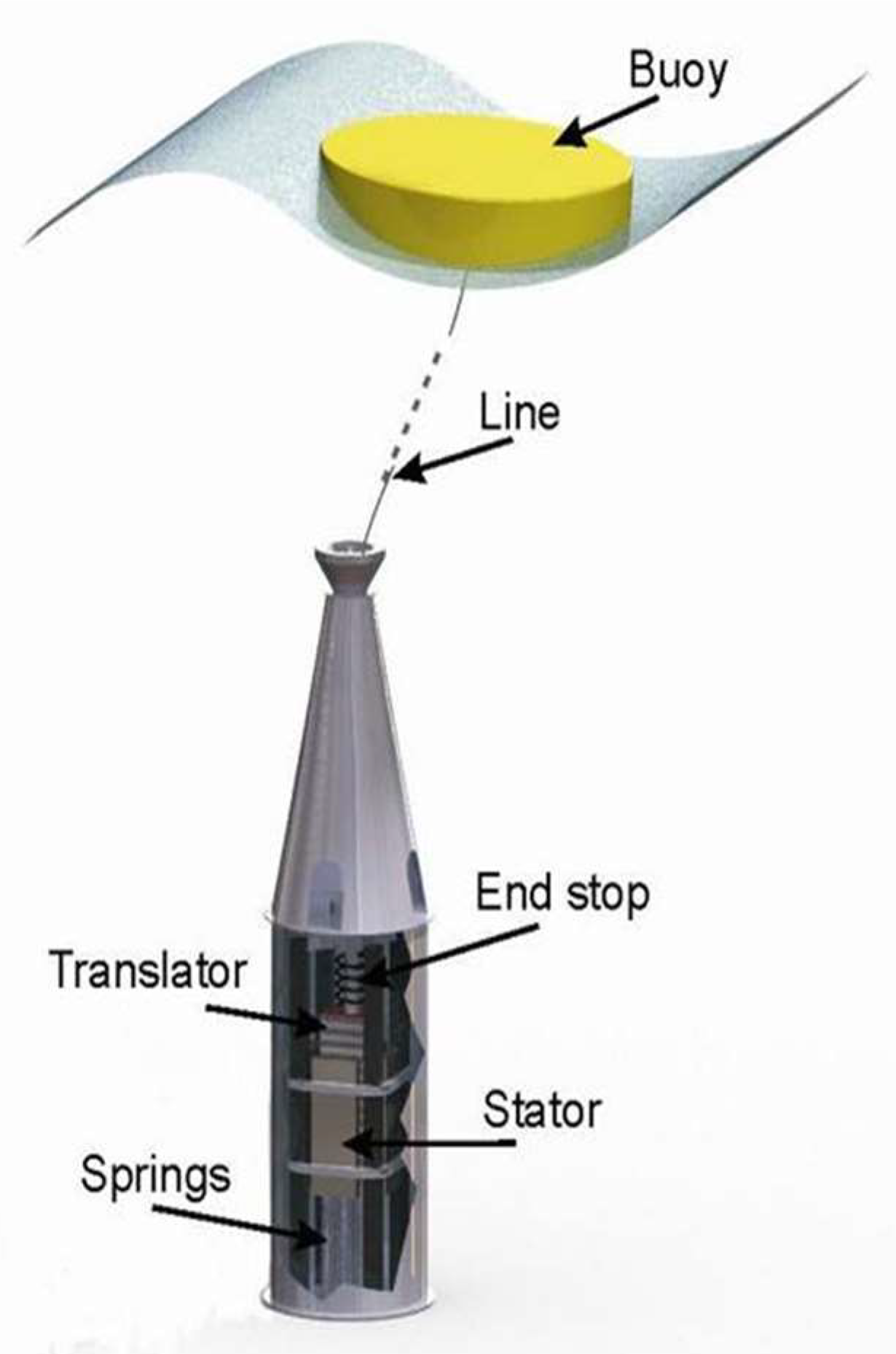
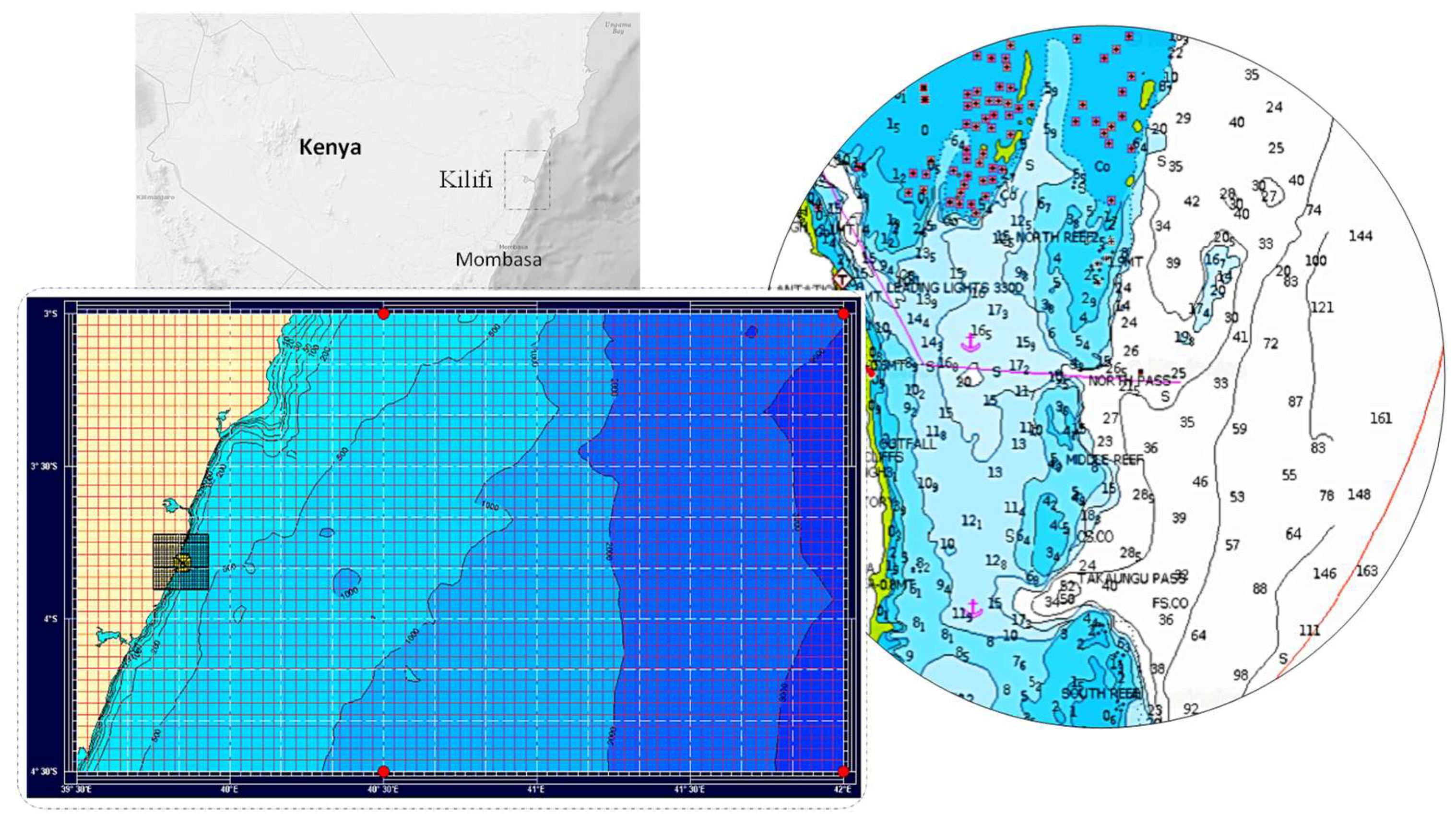
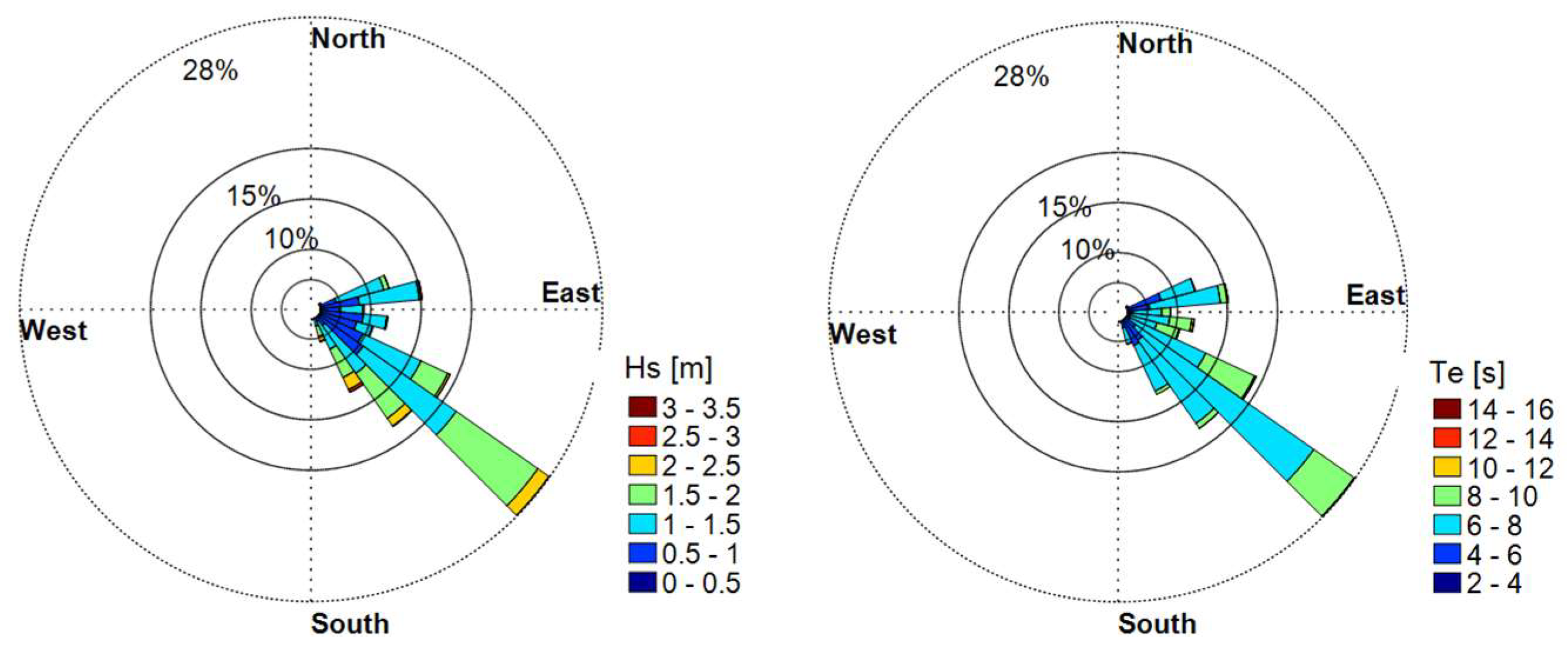

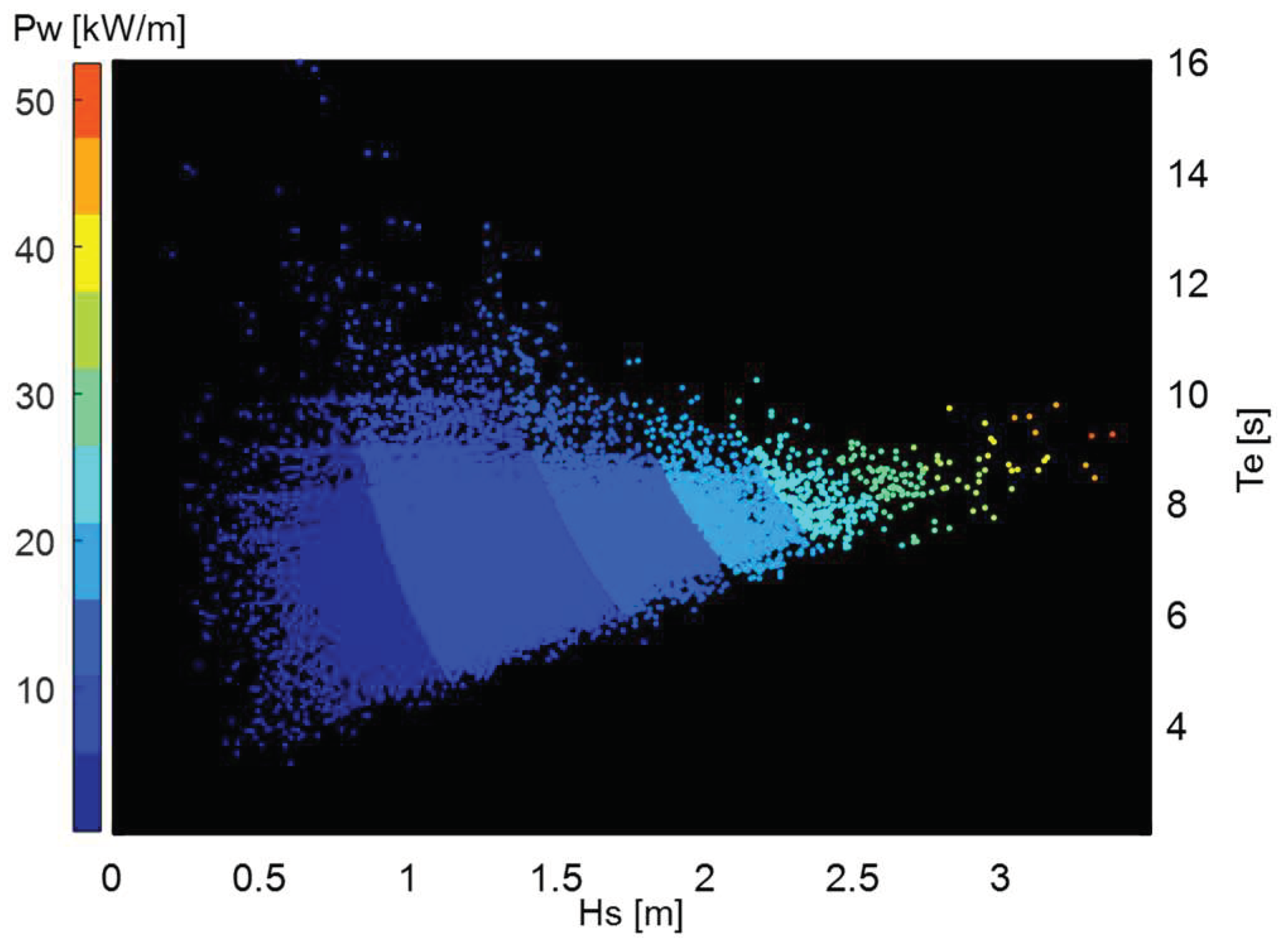
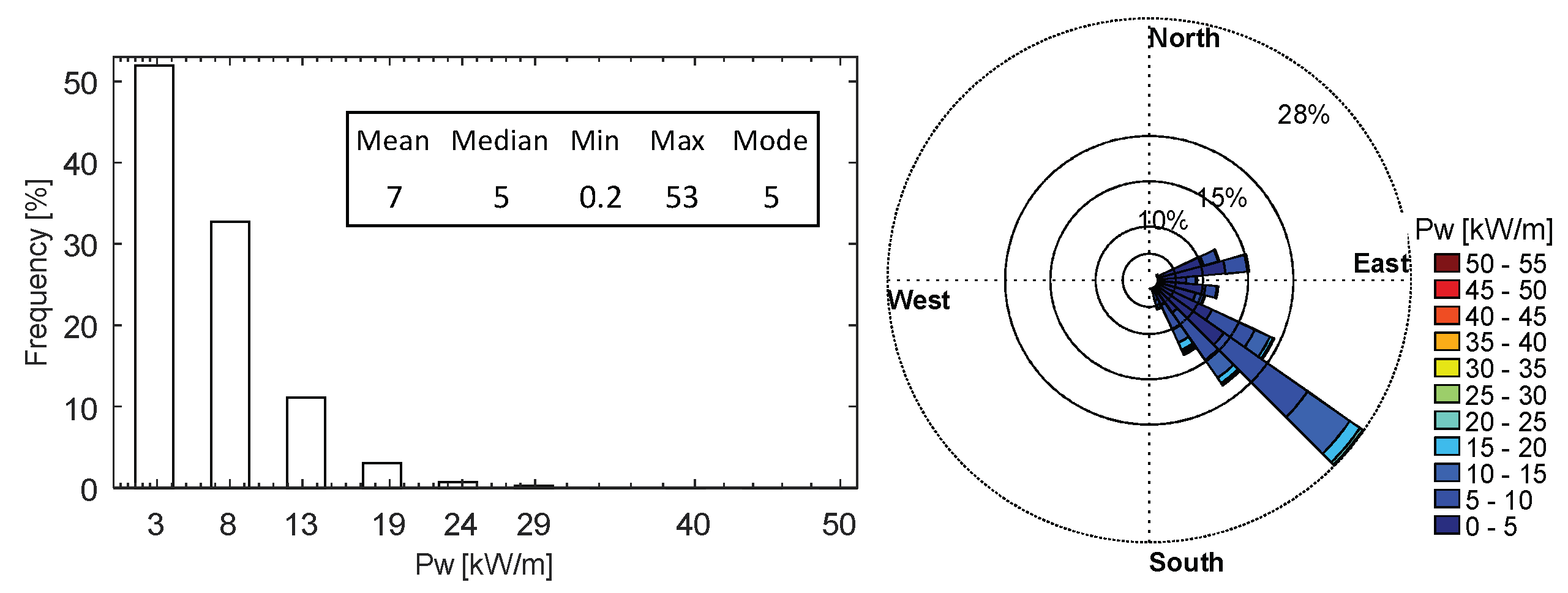
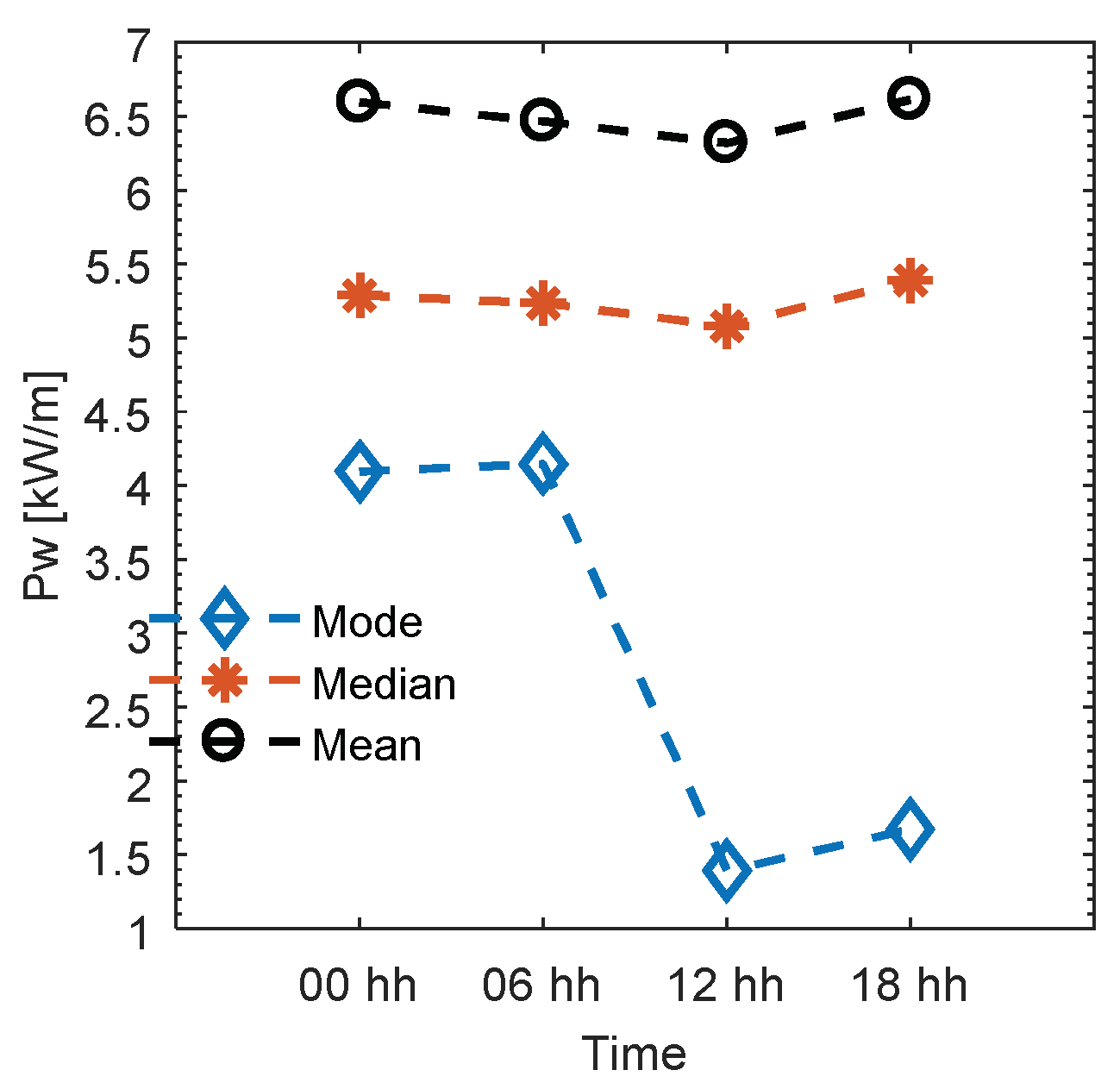
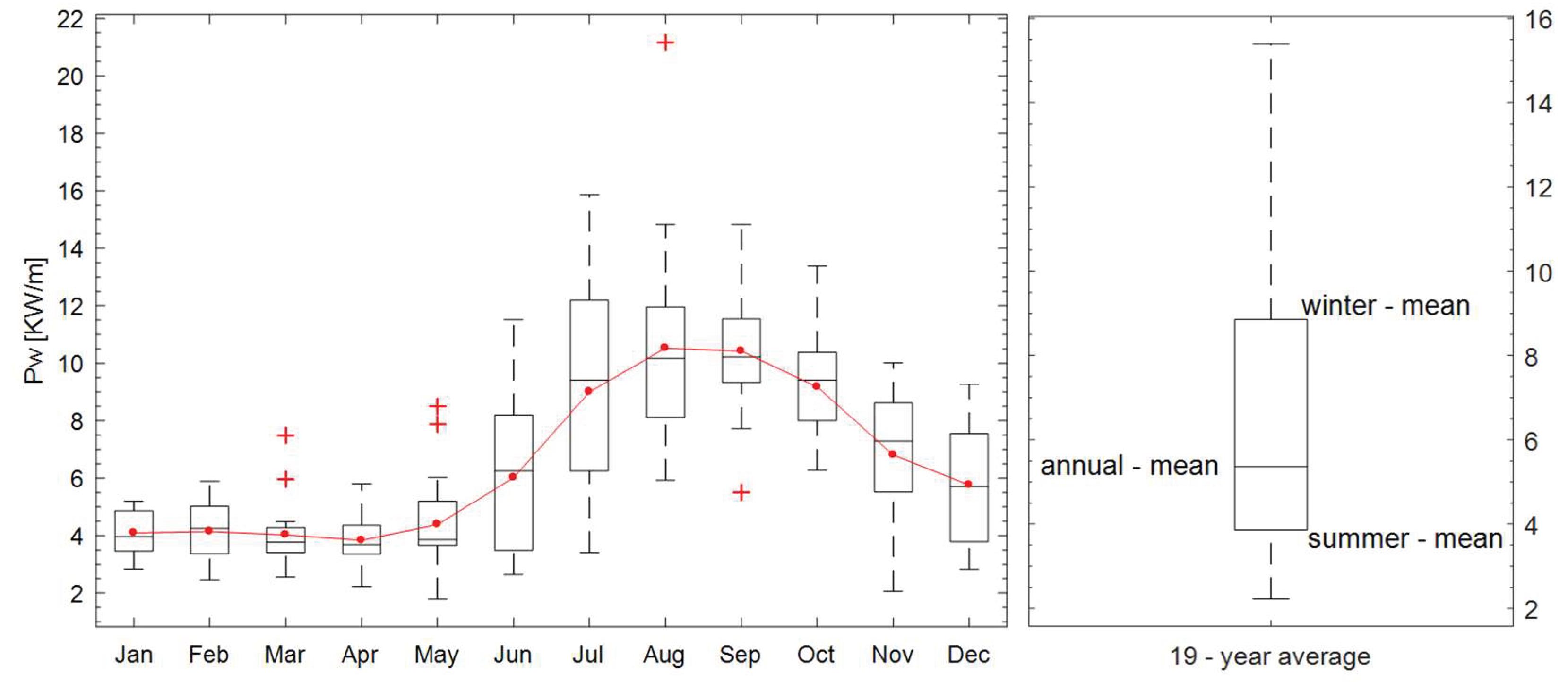

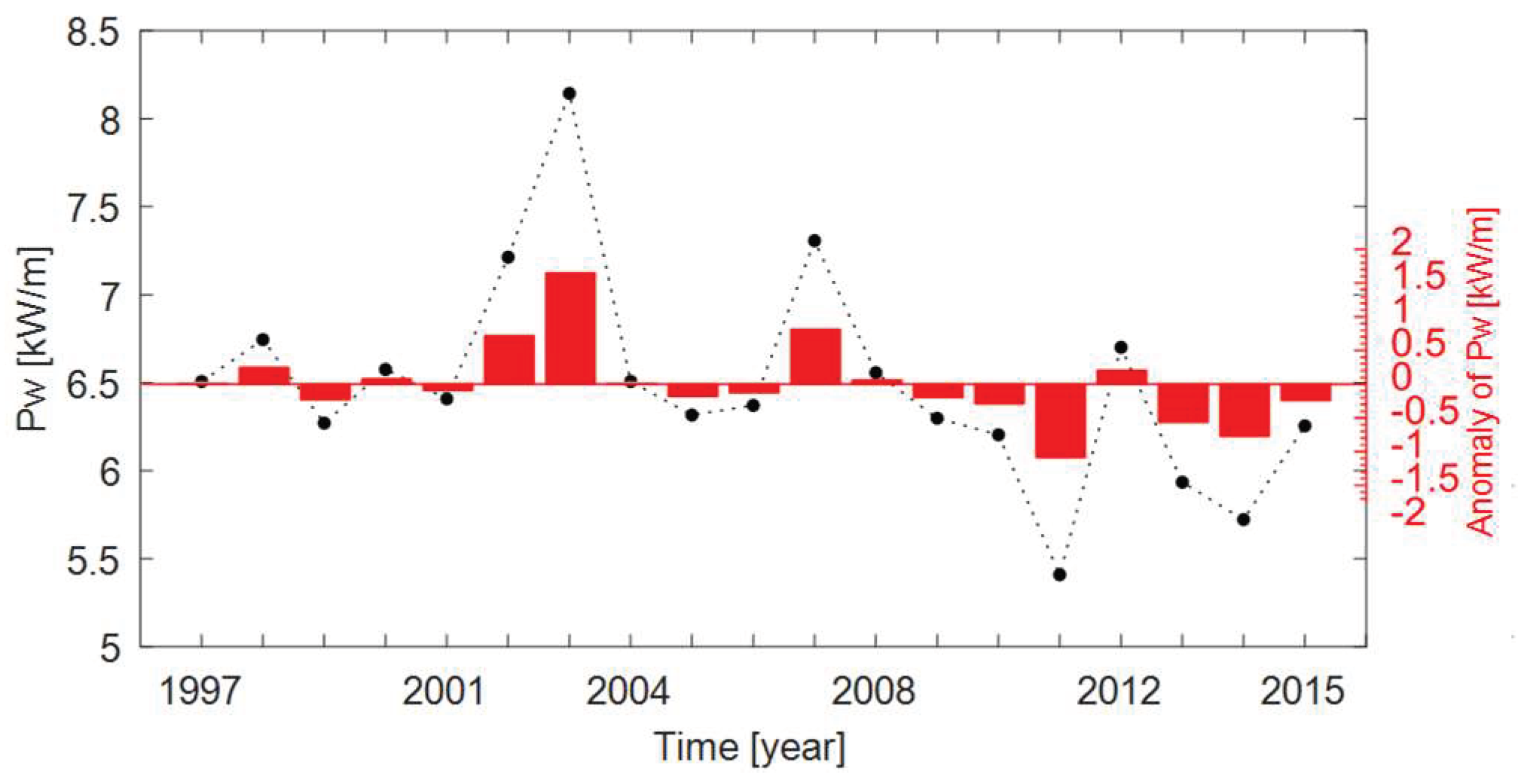
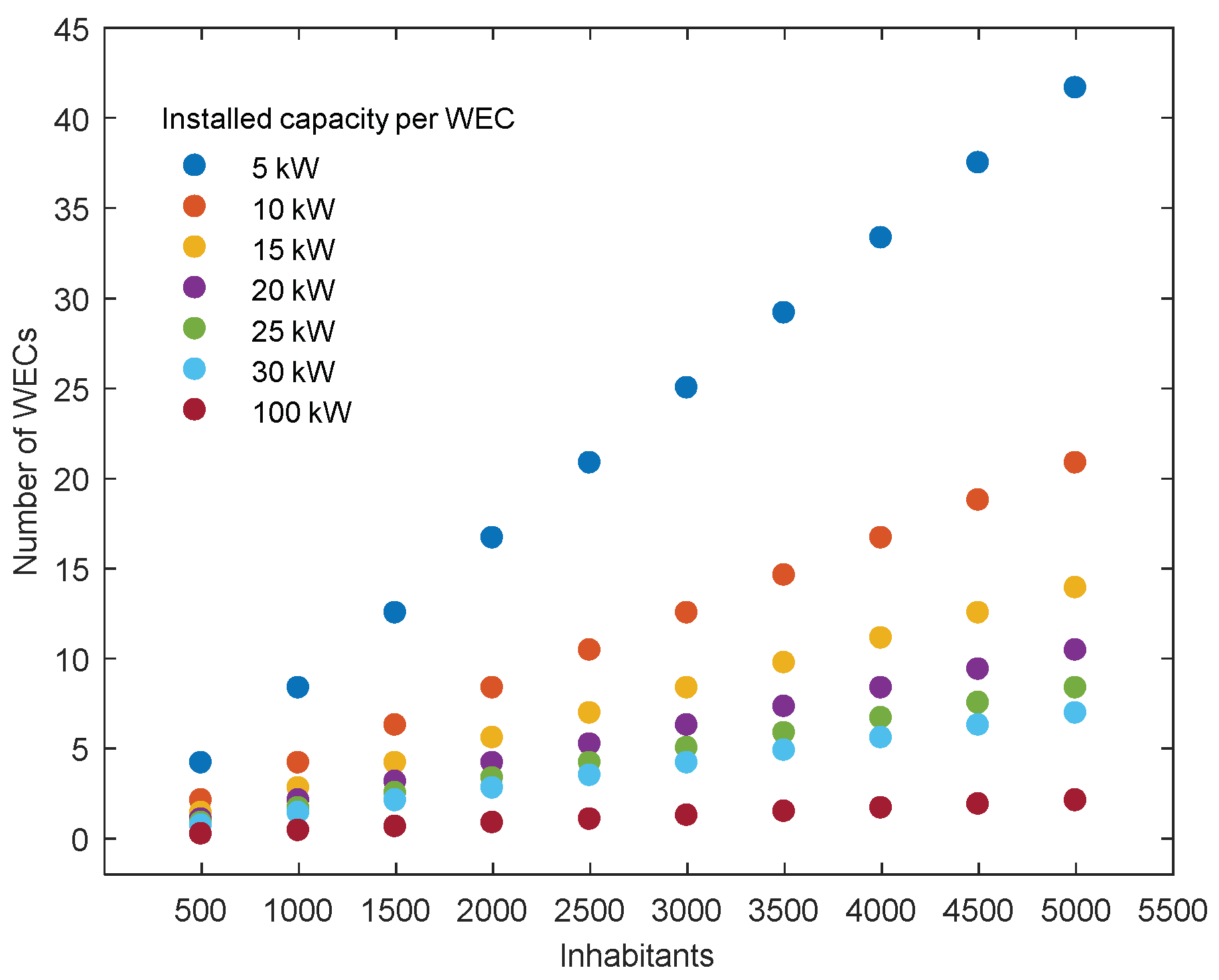
© 2018 by the authors. Licensee MDPI, Basel, Switzerland. This article is an open access article distributed under the terms and conditions of the Creative Commons Attribution (CC BY) license (http://creativecommons.org/licenses/by/4.0/).
Share and Cite
Francisco, F.; Leijon, J.; Boström, C.; Engström, J.; Sundberg, J. Wave Power as Solution for Off-Grid Water Desalination Systems: Resource Characterization for Kilifi-Kenya. Energies 2018, 11, 1004. https://doi.org/10.3390/en11041004
Francisco F, Leijon J, Boström C, Engström J, Sundberg J. Wave Power as Solution for Off-Grid Water Desalination Systems: Resource Characterization for Kilifi-Kenya. Energies. 2018; 11(4):1004. https://doi.org/10.3390/en11041004
Chicago/Turabian StyleFrancisco, Francisco, Jennifer Leijon, Cecilia Boström, Jens Engström, and Jan Sundberg. 2018. "Wave Power as Solution for Off-Grid Water Desalination Systems: Resource Characterization for Kilifi-Kenya" Energies 11, no. 4: 1004. https://doi.org/10.3390/en11041004





